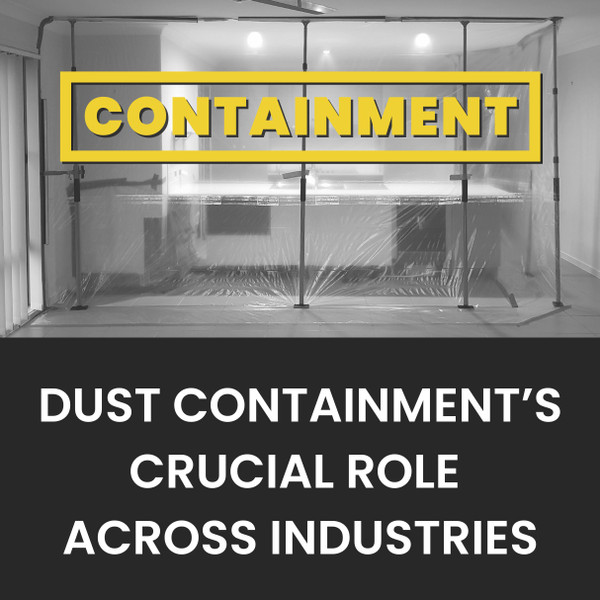Dust Containment’s Crucial Role Across Industries
Dust containment walls are essential in many industries, including restoration, construction, healthcare, and manufacturing. When dealing with water damage, mould, fire damage, or hazardous materials, using containment strategies prevents contaminants from spreading, protects health, and enhances operational efficiency. Here’s why dust containment is so important:
Preventing Further Damage
- Water Damage: Plastic containment walls stops water from reaching unaffected areas, reducing the extent of damage. This minimises restoration costs and prevents secondary issues like structural damage or mould growth.
- Mould Damage: Sealing off mouldy areas stops spores from spreading throughout the building. This controls mould growth and reduces health risks for occupants.
- Fire Damage: Containment limits the spread of smoke and soot, which can severely damage materials and surfaces. By isolating the affected area, professionals can focus on cleaning and repairing damaged sections.
- Hazardous Materials: Cutting stone or concrete in construction or masonry releases harmful dust particles. Silica dust, released during these processes, poses serious health risks like respiratory illnesses and silicosis. Containment prevents these fibres from spreading into the environment.
Protecting Health
- Mould Exposure: Mould can cause respiratory issues, allergies, and headaches. Containment reduces exposure risk by preventing spores from circulating in the building.
- Fire Damage: Smoke and soot contain harmful chemicals that can irritate the eyes, nose, and throat. Containment minimises exposure to these contaminants.
- Asbestos Removal: Containment is vital when removing asbestos materials to prevent dangerous fibres from being released into the air. Sealed enclosures and negative pressure systems keep these fibres from spreading.
- Silica Dust Control: Cutting or drilling stone or concrete releases silica dust, which can cause lung disease if inhaled. Containment barriers and air filtration systems with HEPA filters prevent this toxic dust from spreading. Workers may also wear respirators to avoid inhaling dangerous fibres.
Improving Efficiency
- Water Damage: Containment allows professionals to concentrate on affected areas, improving efficiency and reducing restoration time.
- Mould Damage: Sealing off mouldy areas makes it easier to remove spores using air scrubbers or HEPA vacuums.
- Fire Damage: Containment prevents smoke and soot from spreading, simplifying cleaning and restoration.
- Odour Control: In sewage cleanup or fire restoration, containment helps prevent odours from spreading. Air filtration devices like HEPA filters capture unpleasant smells at the source.
Cost-Effectiveness
- Water Damage: Containment lowers restoration costs by limiting damage and preventing further issues.
- Mould Damage: Temporary containment walls stops mould from spreading, reducing the remediation work required.
- Fire Damage: Containment limits smoke and soot spread, reducing cleaning and restoration costs.
- Silica and Hazardous Dust: Containment during construction or renovation prevents dust from spreading, lowering cleanup time and costs. It also protects equipment from dust damage, reducing maintenance expenses.
Containment Strategies
Several strategies help contain damaged areas:
- Physical Barriers: Use tarps, plastic sheeting, and temporary walls.
- Air Barriers: Control airflow to stop contaminants from spreading.
- Negative Air Pressure: Create a low-pressure area in the damaged zone to prevent air and contaminants from moving.
- HEPA Filters and Vacuums: They capture tiny particles like mould spores, asbestos fibres, and dust. This keeps the worksite and surrounding areas clean.
Applications Across Industries
Dust containment is vital not only in restoration but also in:
- Healthcare: Helps control infections during construction or renovations by stopping airborne pathogens from reaching sterile or patient areas.
- Construction: Prevents dust from spreading to occupied or sensitive spaces during building or renovation.
- Manufacturing: Used in environments dealing with hazardous materials like chemicals or metals to contain dust and maintain safety.
- Stone Masonry and Bench top Fabrication: Essential for controlling silica dust when cutting stone bench tops. Using containment systems, water suppression, and HEPA filters protects workers from serious health issues like silicosis and lung cancer.
Negative Pressure Containment
Negative pressure containment is important for stopping airborne contaminants. This is especially true in restoration and construction tasks. These tasks include fire and water damage cleanup, mould removal, and handling toxic materials.
How It Works:
- Containment Barriers: Physical barriers isolate the affected area.
- Creating Negative Pressure: High-powered fans or air movers create lower air pressure inside the containment area. This pressure is lower than in the surrounding space. This setup makes sure that the fans pull in airborne contaminants. The fans filter these contaminants before blowing them outside.
Benefits:
- Contaminant Control: Prevents harmful substances from spreading to other building areas.
- Worker Safety: Protects workers from exposure to hazardous materials.
- Property Protection: Minimises damage to unaffected parts of the building.
- Common Applications:
- Fire Damage: Stops soot and smoke from spreading.
- Water Damage: Controls mould growth and bacteria spread.
- Mould Remediation: Isolates affected areas to prevent spore spread.
- Biohazard Cleanup: Contains hazardous materials like blood or bodily fluids.
By creating a negative pressure environment, professionals can effectively contain and eliminate contaminants, ensuring a safe and efficient process.
Containment is critical in many industries, helping prevent the spread of harmful substances and protecting health. Negative pressure containment, along with tools like HEPA filters and water suppression systems, keeps toxic materials safe. This includes mould, asbestos, and silica dust. By using proper containment strategies, professionals can manage risks, improve efficiency, and reduce costs.
Restore Solutions’ Containment Products
Restore Solutions offers a range of dust containment products. These products isolate contaminated areas to prevent the spread of dust, debris, and hazardous materials.
- ContainIT: A versatile dust containment system with curtains, seals, and a carrying bag for easy setup and storage.
- Curtain-Wall: Provides flame-retardant products and easily transportable chamber solutions operable by one person.
- HeyWall: A German-designed wall system that seals at the sides and can be extended to any length using provided plastic.
- ZipWall Barrier System: A quick and easy barrier system for dust containment.
Complementary Products
- CleanSpace Respirators: Provide respiratory protection for workers in contaminated areas.
- HEPA Vacuums: High-efficiency particulate air vacuums that capture fine particles.
- Chemicals and Sponges: Used for cleaning and removing mould, fire and smoke damage, biohazards, and other contaminants.
- Sprayers: For applying cleaning solutions or disinfectants.
- Air Cleaners: Devices that filter contaminated air within containment zones before expelling it.
For a comprehensive list and detailed information, please see our range of Dust Containment products.
Recent Posts
-
Start the Year Strong with Our Restocking Service
Because the busiest season is when you need the fewest surprises. The new year is already in full sw …3rd Jan 2026 -
Ten Years of Restore Solutions: Innovation for Restorers
In 2015, Restore Solutions entered the market with one clear purpose — to help restoration professio …2nd Dec 2025 -
The Ultimate Battery Operated Power Scrubber for Restoration Professionals
Less Elbow Grease, More Results: Meet the Battery-Powered Scrubber That Does the Hard Work for You S …17th Nov 2025




